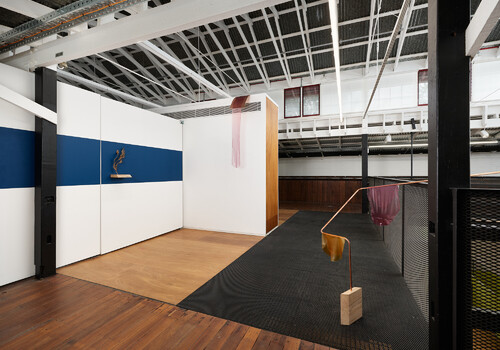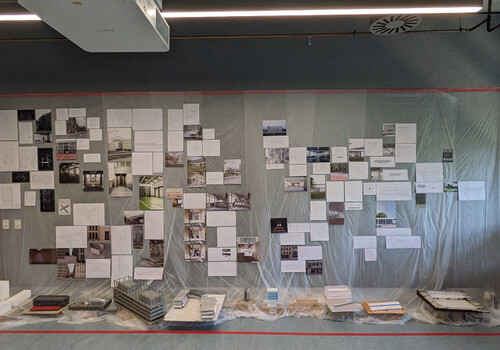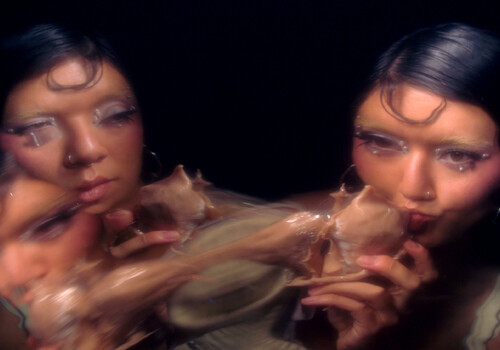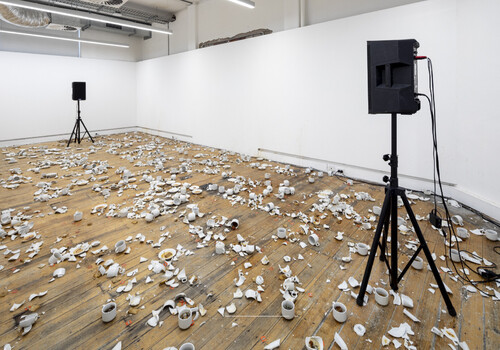Painting, Sydney College of the Arts
By Solomiya Sywak
Painting has always been seen as the pinnacle of art and every year the Sydney College of the Arts graduate exhibition, ‘New Contemporaries’, seems to overflow with the panic of turpentine soaked walls adorned with what students aim to be the next it-painting. But this year felt different. Here, there’s no room for anxiety—only a bold call to a small collective of painters to move beyond its general constructs of painting and to finally make it their own. Away from the confines of the canvas, students experimented with ways of seeing, from introspective blurred memories to brash studies of the formal self. Why reinvent the wheel when you can paint it on a claustrophobic canvas?
Third-year-painter Kate Leckie explores the possibilities at the intersection of painting and sculpture. Leckie experiments with mapping the face in 2D projections, slicing up head after head to create a Frankenstein’s monster of renderings. The canvas becomes the forerunner to the papier-mâché realisation, as Leckie aims to prove “a manifestation of how portrait painting could involve 3D thinking”. In doing so, Leckie challenges traditional boundaries, urging a reevaluation of portraiture that extends beyond flat representation into a transformative exploration of form and perception.

Kate Leckie, 31 Heads, 2024, acrylic on board, canvas and papier-mâché. Photo: Document Photography.
Honours student Enya Fitzpatrick also screws with portraiture, reframing it as a genre for depicting memory rather than the image of a sitter. Fitzpatrick’s triptych of paintings depicts scenes from the artist’s own memories of a fragmented familial history as Irish immigrants: a blurry tower, two children holding hands on a pavement, a yard covered with snow. The warped fields of vision in What’s Mine is Yours: A Lifetime of Love and Longing (2024) create a dreamlike quality, obscurity placing these scenes somewhere between the sharp clarity of photographic documentation and the blurry subjectivity of personal memory. In a similar way, the cool impersonal blue of the two side pieces is balanced with the warm and homely yellows, pinks and reds of the central panel. In this way, the triptych becomes an altarpiece, an ode to the childlike wonders that create Fitzpatrick’s memories—one she now yearns to relive through paint.

Enya Fitzpatrick, What’s Mine is Yours: A Lifetime of Love and Longing, 2024, oil on canvas. Photo: Document Photography.
PhD student Lana Ryles uses the sharp geometric lines of a grid to track concepts of abstraction, paraphysics, and neuroscience. In one trio of works Ryles overlays her grids with vibrant robotic images of swirls, circles and angles, undoing the grid’s stark flatness with movement and energy. In The Weather (2024), Ryles interleaves a circuit of straight lines with icons of stars. This work evokes the work of early twentieth-century Ukrainian avant-gardist Kazimir Malevich, who similarly sought to use abstract form to equate the “movement of conceptions” in the mind with the cosmic dance of the sun and stars. Ryles invites viewers to reflect on the interconnectedness of human perception, science, and the cosmos—offering a visual manifestation of thought in constant flux.

Lana Ryles, The Weather, 2024, acrylic on canvas. Photo: Document Photography.
These and other works in the exhibition show artists pushing at the limits of painting’s conventions. Outnumbered by newer media, like photomedia or moving image, the humble painting appears in this show as an important site of experimentation for this cohort of artists. The painters of the SCA grad show an inquisitive spirit, learning and relearning what painting can be.
Solomiya Sywak is a Ukrainian Australian artist and writer working on Gadigal land.









































